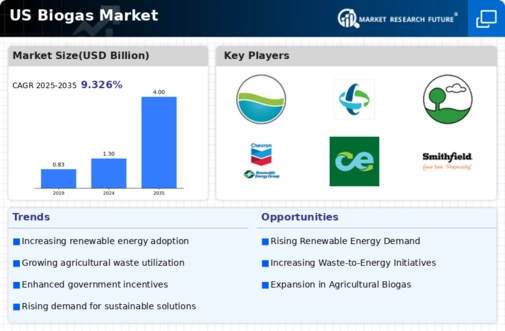The US Biogas Market is a rapidly evolving landscape characterized by a growing emphasis on renewable energy sources and sustainability. With increasing regulatory support aimed at reducing greenhouse gas emissions and promoting clean energy alternatives, various players within this market are seeking to leverage biogas technologies to capture organic waste and convert it into usable energy forms.
The competitive dynamics are shaped by factors such as technological advancements, policy incentives, and strategic collaborations among companies, all of which play a significant role in determining market positioning and growth trajectories.
The market is being influenced by factors such as the accessibility of feedstock, infrastructure development, and awareness of environmental concerns among consumers and businesses, driving a greater adoption of biogas solutions. As competitors innovate, the landscape becomes more nuanced, with companies focusing on various segments, including agricultural waste, municipal solid waste, and industrial by-products.
Bioenergy DevCo has established a strong presence in the US Biogas Market through its innovative approaches and robust project execution capabilities. The company focuses on developing anaerobic digestion facilities, which effectively convert organic waste into biogas while simultaneously addressing the challenge of waste management.
One of the core strengths of Bioenergy DevCo lies in its ability to forge strategic partnerships with local governments and agricultural entities, enhancing its operational efficiency and community engagement initiatives.
Additionally, the company’s commitment to environmental stewardship resonates well with stakeholders, thereby increasing its credibility and trust within target markets. By leveraging cutting-edge technologies and a dedicated workforce, Bioenergy DevCo continues to position itself as a leader in the biogas sector, showcasing its potential to innovate and expand its portfolio across the United States.
Duke Energy is another pivotal player in the US Biogas Market, actively engaged in harnessing renewable energy through enhanced infrastructure and innovative solutions. The company focuses on integrating biogas from agricultural operations and landfills into its broader energy portfolio, representing a key initiative in its sustainability strategy. By investing in anaerobic digestion and collaborating with various stakeholders, such as farmers and municipal waste authorities, Duke Energy is innovatively addressing waste management while creating energy.
The company’s extensive market presence is bolstered by its well-established reputation and financial resources, which enable it to drive multiple projects simultaneously. Duke Energy also seeks growth opportunities through mergers and acquisitions that allow it to enhance its biogas capabilities and expand its operational footprint. With a commitment to reducing carbon emissions and advancing renewable energy solutions, Duke Energy is well-positioned to contribute significantly to the evolving landscape of the US Biogas Market.



















Leave a Comment